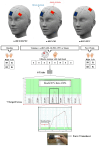Site Dependency of Anodal Transcranial Direct-Current Stimulation on Reaction Time and Transfer of Learning during a Sequential Visual Isometric Pinch Task
- PMID: 38672057
- PMCID: PMC11048073
- DOI: 10.3390/brainsci14040408
Site Dependency of Anodal Transcranial Direct-Current Stimulation on Reaction Time and Transfer of Learning during a Sequential Visual Isometric Pinch Task
Abstract
Considering the advantages of brain stimulation techniques in detecting the role of different areas of the brain in human sensorimotor behaviors, we used anodal transcranial direct-current stimulation (a-tDCS) over three different brain sites of the frontoparietal cortex (FPC) in healthy participants to elucidate the role of these three brain areas of the FPC on reaction time (RT) during a sequential visual isometric pinch task (SVIPT). We also aimed to assess if the stimulation of these cortical sites affects the transfer of learning during SVIPT. A total of 48 right-handed healthy participants were randomly assigned to one of the four a-tDCS groups: (1) left primary motor cortex (M1), (2) left dorsolateral prefrontal cortex (DLPFC), (3) left posterior parietal cortex (PPC), and (4) sham. A-tDCS (0.3 mA, 20 min) was applied concurrently with the SVIPT, in which the participants precisely controlled their forces to reach seven different target forces from 10 to 40% of the maximum voluntary contraction (MVC) presented on a computer screen with the right dominant hand. Four test blocks were randomly performed at the baseline and 15 min after the intervention, including sequence and random blocks with either hand. Our results showed significant elongations in the ratio of RTs between the M1 and sham groups in the sequence blocks of both the right-trained and left-untrained hands. No significant differences were found between the DLPFC and sham groups and the PPC and sham groups in RT measurements within the SVIPT. Our findings suggest that RT improvement within implicit learning of an SVIPT is not mediated by single-session a-tDCS over M1, DLPFC, or PPC. Further research is needed to understand the optimal characteristics of tDCS and stimulation sites to modulate reaction time in a precision control task such as an SVIPT.
Keywords: a-tDCS; anodal transcranial direct-current stimulation; dorsolateral prefrontal cortex; posterior parietal cortex; primary motor cortex; reaction time; transfer learning.
Conflict of interest statement
This research did not receive any specific grant from funding agencies in the public, commercial, or not-for-profit sectors.
Figures






Similar articles
-
Single-Session Anodal tDCS with Small-Size Stimulating Electrodes Over Frontoparietal Superficial Sites Does Not Affect Motor Sequence Learning.Front Hum Neurosci. 2017 Apr 3;11:153. doi: 10.3389/fnhum.2017.00153. eCollection 2017. Front Hum Neurosci. 2017. PMID: 28420970 Free PMC article.
-
Complex sequential learning is not facilitated by transcranial direct current stimulation over DLPFC or M1.Eur J Neurosci. 2024 Apr;59(8):2046-2058. doi: 10.1111/ejn.16255. Epub 2024 Jan 25. Eur J Neurosci. 2024. PMID: 38270331
-
Effects of anodal transcranial direct current stimulation on implicit motor learning and language-related brain function: An fMRI study.Psychiatry Clin Neurosci. 2021 Jun;75(6):200-207. doi: 10.1111/pcn.13208. Epub 2021 Mar 10. Psychiatry Clin Neurosci. 2021. PMID: 33576537 Clinical Trial.
-
Transcranial Direct Current Stimulation Targeting Primary Motor Versus Dorsolateral Prefrontal Cortices: Proof-of-Concept Study Investigating Functional Connectivity of Thalamocortical Networks Specific to Sensory-Affective Information Processing.Brain Connect. 2017 Apr;7(3):182-196. doi: 10.1089/brain.2016.0440. Brain Connect. 2017. PMID: 28142257 Free PMC article. Clinical Trial.
-
The Effect of a Single Session of Non-Invasive Brain Stimulation on Balance in Healthy Individuals: A Systematic Review and Best Evidence Synthesis.Brain Connect. 2021 Nov;11(9):695-716. doi: 10.1089/brain.2020.0872. Epub 2021 Sep 3. Brain Connect. 2021. PMID: 33798002
References
-
- Cohen A., Ivry R.I., Keele S.W. Attention and structure in sequence learning. J. Exp. Psychol. Learn. Mem. Cogn. 1990;16:17. doi: 10.1037/0278-7393.16.1.17. - DOI
LinkOut - more resources
Full Text Sources

